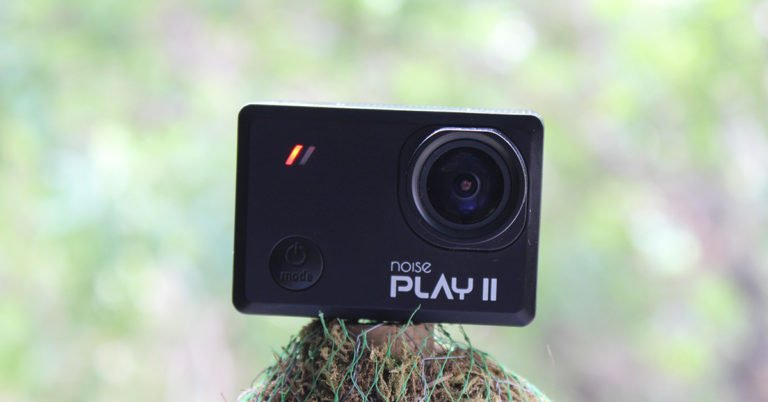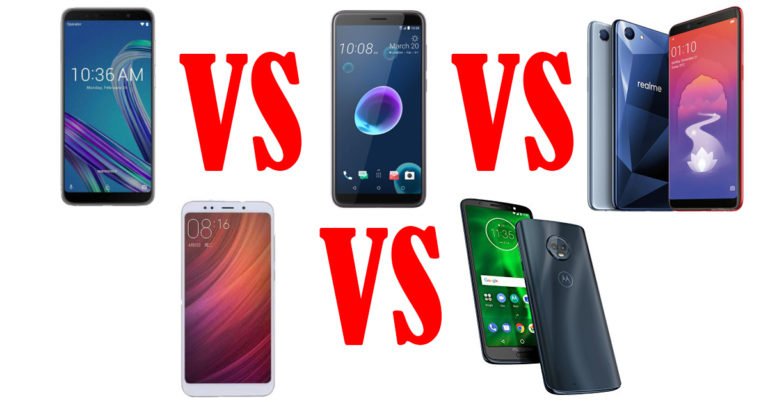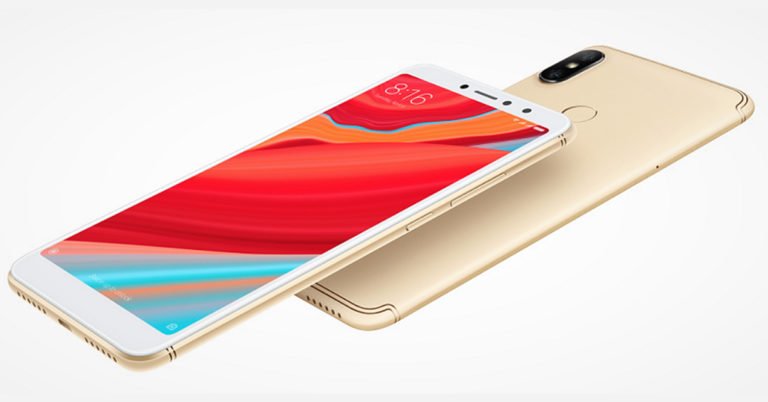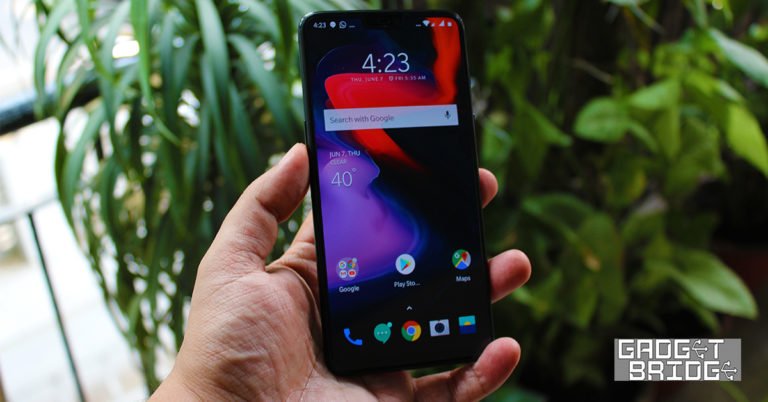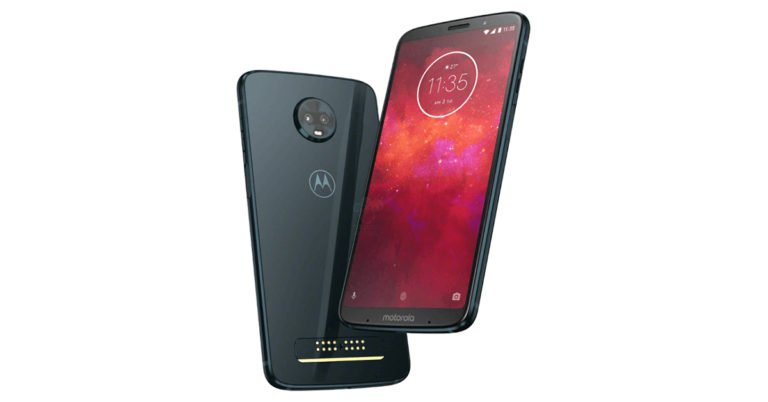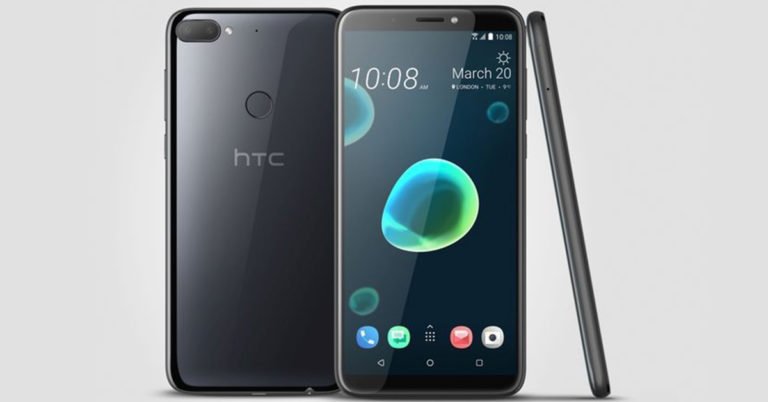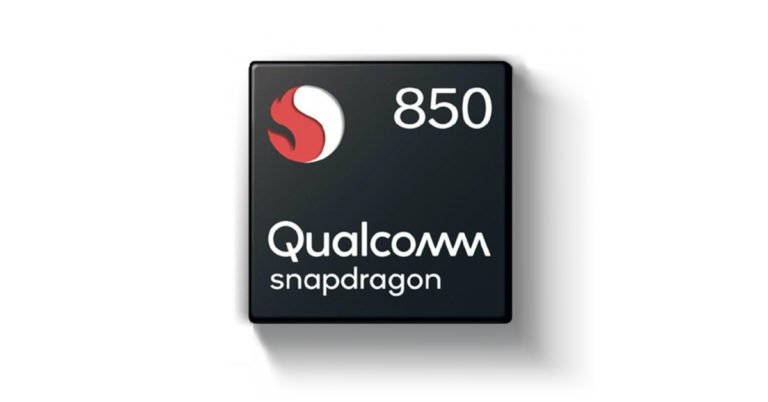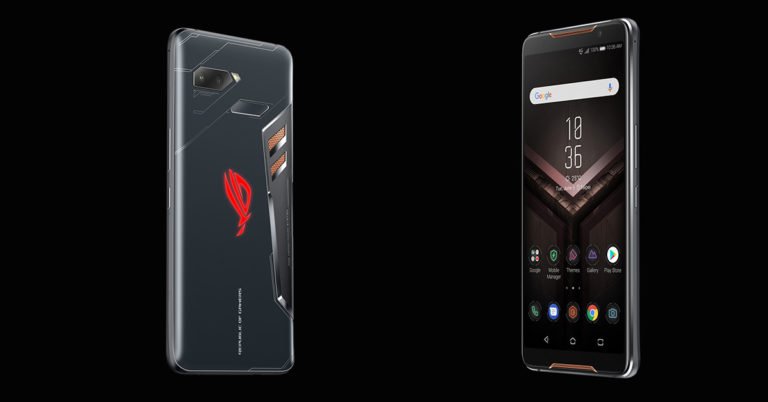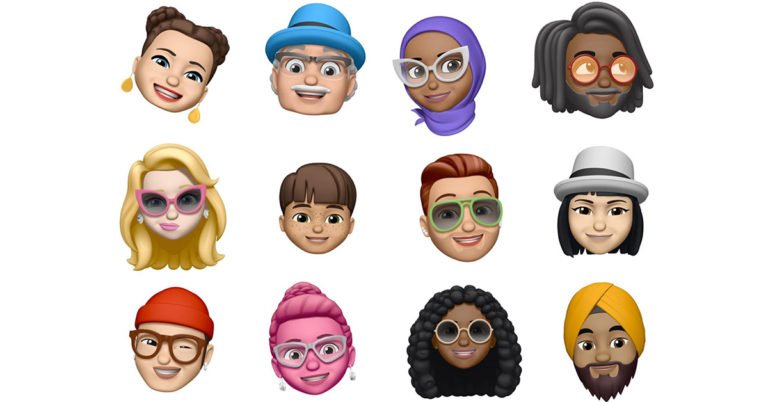[Video] Moto G6 First Look and Box contents
Moto G6 is out in the Indian market at a starting price of Rs 13,999 for 3GB RAM/3GB Memory and Rs 15,999 for 4GB RAM/64GB Memory. We have with us the later one. Check out the first look video which has all the details and our views of the newly launched smartphone.
Go Noise Play 2 unboxing and first look
We got the Go Noise Play 2 and here is the unboxing and first look videos. Lot of components inside in this neat camera that retails for Rs 9,999.
Tech Specs:
| Image Sensor | ||
| 16 MP | ||
| Lens | ||
| F2.8 Aperture, 7G glass | ||
| Display | ||
| 2.0″TFT LCD Touchscreen | ||
| Ports | ||
| Mini USB , Micro HDMI, Micro SD Slot | ||
| Storage | ||
| MicroSD memory card with Class 10 or UHS-1 rating required | ||
| Up to 128GB capacity supported | ||
| Battery + Charging | ||
| Rechargeable lithium-ion battery | ||
| Battery Capacity: 1200mAh | ||
| USB Charging: DC 5V 1000 mA | ||
| APP | ||
| Android (Google Play Store) – https://play.google.com/store/apps/details?id=com.haotek.play iOS – Coming Soon | ||
| Video | ||
| Resolution | Frame Size | Frame Per Rate (fps) |
| 4K (2880*2160) | 16:9 | 24 |
| 4k (2880*2160) | 4:3 | 24 |
| QHD (2560*1440) | 16:9 | 30 |
| QHD (2560*1440) | 4:3 | 30 |
| 1296 (2304*1296)16:9 | 16:9 | 30 |
| Full HD(1920*1080)16:9 | 16:9 | 60 |
| 1080 (1920*1080) | 16:9 | 30 |
| Full HD (1440*1080) | 4:3 | 30 |
| HD 720 (1280*720) | 16:9 | 120 |
| HD 720 (1280*720) | 16:9 | 60 |
| HD 720 (1280*720) | 16:9 | 30 |
| WVGA (848*480) | 16:9 | 30 |
| VGA (640*480) | 4:3 | 240 |
| Photo | ||
| Resolution | ||
| 16MP | 4:3 | |
| 14 MP | 4:3 | |
| 12 MP | 16:9 | |
| 12MP | 4:3 | |
| 10MP | 16:9 | |
| 10MP | 4:3 | |
| 8MP | 16:9 | |
| 8MP | 4:3 | |
| VGA | 4:3 | |
| Time Lapse Photo | ||
| 0.5S / 1S / 2S / 5S / 10S / 30S / 60S | ||
Super Comparison: Moto G6 vs Xiaomi Redmi Note 5 Pro vs Oppo Realme 1 vs Asus Zenfone Max Pro M1 vs HTC Desire 12
The budget segment of Indian smartphone market has seen a number of new entrants this year. Starting from Xiaomi Redmi Redmi Note 5 Pro, a slew of smartphones have been launched in this category off late. These include Oppo Realme 1, Asus Zenfone Max Pro M1 and the very recently launched Moto G6 and HTC Desire 12. If you are confused about which one you should buy, reading our comparison will help you decide which among these five smartphones is the right one for you. Here’s our spec-to spec comparison of Xiaomi Redmi Note 5 Pro, Moto G6, Oppo Realme 1, Asus Zenfone Max Pro M1, and HTC Desire 12.
Display
Moto G6: 5.7-inch FHD+ IPS touch screen
Oppo Realme 1: 6-inch full-HD+ (1080x2160p) display
Xiaomi Redmi Note 5 Pro: 5.99-inch FHD+ display with 18:9 aspect ratio
Asus Zenfone Max Pro M1: 5.99-inch full HD+ display with 18:9 aspect ratio
HTC Desire 12: 5.5-inch HD+ IPS display with 18:9 aspect ratio
Processor
Moto G6: 1.8GHz Octa-core GHz Qualcomm snapdragon 450 CPU clubbed with Adreno 506 GPU
Oppo Realme 1: MediaTek’s 12nm octa-core Helio P60 processor
Xiaomi Redmi Note 5 Pro: Qualcomm Snapdragon 636 processor
Asus Zenfone Max Pro M1: Qualcomm Snapdragon 636 processor
HTC Desire 12: Quad-core MediaTek MT6739 processor
Primary camera
Moto G6: Dual rear cameras with 12MP and 5MP sensors.
Oppo Realme 1: 13MP rear camera. The camera app supports AR stickers that can be applied to photos taken by both rear and selfie cameras.
Xiaomi Redmi Note 5 Pro: Dual rear camera setup with 12MP and 5MP sensors.
Asus Zenfone Max Pro M1: 13MP+5MP dual rear cameras with LED flash. (A variant with 16MP+5MP dual rear cameras will be launched soon).
HTC Desire 12: 13MP rear camera.
Selfie camera
Moto G6: 5MP front facing camera for selfies and video calls.
Oppo Realme 1: 8MP front facing camera with AI Beauty 2.0 feature.
Xiaomi Redmi Note 5 Pro: 20 selfie camera with LED flash and Xiaomi’s AI learning mechanism.
Asus Zenfone Max Pro M1: 8MP front-facing snapper with Snapdragon camera app interface.
HTC Desire 12: 5MP front facing camera.
RAM and storage
Moto G6: The smartphone is available in two storage variants — 3GB RAM/32GB storage and 4GB RAM/64GB internal storage.
Oppo Realme 1: 3GB RAM/32GB internal storage, 4GB RAM/64GB onboard storage and 6GB RAM/128GB storage.
Xiaomi Redmi Note 5 Pro: 4GB RAM/64GB internal storage, 6GB RAM/64GB onboard storage
Asus Zenfone Max Pro M1: The smartphone is currently available in 3GB RAM/32GB onboard storage and 4GB RAM/64GB internal storage variants. A new variant with 6GB RAM/64GB storage is also expected.
HTC Desire 12: 3GB RAM, 32GB of internal storage
Support for microSD card
Moto G6: Up to 128GB
Oppo Realme 1: Up to 256GB
Xiaomi Redmi Note 5 Pro: Up to 128GB
Asus Zenfone Max Pro M1: Up to 2TB
HTC Desire 12: Up to 2TB
Battery
Moto G6: 3,000 mAh
Oppo Realme 1: 3,410mAh
Xiaomi Redmi Note 5 Pro: 4,000mAh
Asus Zenfone Max Pro M1: 5,000mAh
HTC Desire 12: 2,730mAh
Operating system
Moto G6: Android 8.0 Oreo
Oppo Realme 1: Android 8.1 Oreo skinned with ColorOS 5.0
Xiaomi Redmi Note 5 Pro: MIUI 9 based on Android 7.1.1 Nougat
Asus Zenfone Max Pro M1: Android 8.1 Oreo
HTC Desire 12: Android Oreo-based HTC Sense
Price
Moto G6: The 3GB RAM variant is priced at 13,999 and the 4GB RAM version bears a price tag of Rs 15,999.
Oppo Realme 1: Oppo Realme 1’s 3GB RAM variant is priced at Rs 8,990, the 4GB RAM variant costs Rs 10,990, and the 6GB RAM variant bears a price tag of Rs 13,990.
Xiaomi Redmi Note 5 Pro: The 3GB RAM variant costs Rs 14,999 and the 6GB RAM version bears a price tag Rs 16,999.
Asus Zenfone Max Pro M1: The 3GB RAM version costs Rs 10,999 and the 4GB RAM bears a price tag of Rs 12,999. The upcoming 6GB RAM version will be priced at Rs 14,999.
HTC Desire 12: Rs 15,800
Xiaomi Redmi Y2 gets launched in India: Price, specifications and more
Chinese smartphone maker Xiaomi has rolled out the second generation of its selfie focussed smartphone Redmi Y1 that we saw last year. Dubbed Xiaomi Redmi Y2, the smartphone is the companies first device to run Android Oreo out-of-the-box.
Price and availability
Xiaomi Redmi Y2 comes in two variants – 3GB RAM and 32GB internal storage and 4GB RAM and 64GB onboard storage. While the 3GB RAM variant is available at Rs 9,999, the 4GB RAM variant bears a price tag of Rs 12,999.
At this price, the smartphone will compete against the likes of Oppo Realme 1 and Asus Zenfone Max Pro M1. In fact, Oppo Realme 1 also competes with Xiaomi’s smartphone in terms of the features because both are selfie-focussed smartphones.
Xiaomi Redmi Y2 will go on sale on June 12 on Amazon India at 12 noon. As a part of the offers with the smartphone, Airtel is offering a cashback of Rs 1,800 and up to 240GB of 4G data. Furthermore, there is also a cashback of Rs 500 available for purchases made via ICICI credit and debit cards.
Specifications
Available in Dark Grey, Rose Gold and Gold colour variants, Xiaomi Redmi Y2’s key feature is its 16MP front facing camera that comes with auto-HDR and AI Beautify 4.0 feature. The selfie camera of the smartphone is also capable of shooting in Potrait mode. On flipping the phone, you will see 12MP and 5MP dual rear cameras along with an LED flash.
Speaking of other specifications, Xiaomi Redmi Y2 sports a 5.99-inch HD+ screen with a screen resolution of 1440x720p and 269ppi. Powered by Qualcomm Snapdragon 625 processor clubbed with Adreno 506 GPU, it comes with the aforementioned RAM and storage.
Xiaomi Redmi Y2 runs Android Oreo skinned with MIUI 9.5. And like we mentioned earlier, it is the first Xiaomi smartphone to run Android Oreo out of the box.
The newly launched device by Xiaomi houses a 3,080mAh battery and in terms of connectivity, it offers 4G, VoLTE, 3G, Wi-Fi, Bluetooth and GPS.
OnePlus 6 Review: A smartphone that wins because of its superb price
OnePlus is a brand that is really-really smart. They learn from others mistakes and pick up things that are popular today and are trending. Probably the reason why their smartphones do not carry a hefty price tag with them when compared to the Samsung’s and Pixels of the world. In simple words, the other companies do all the R & D and bring out new features and OnePlus just picks the popular ones and incorporate them in their smartphones with the latest hardware.
Now that is not a bad thing at all, we say it is the smart way and a win-win combo. The users get a brilliant phone, not a burning a hole in their pocket when it comes to price and OnePlus sells more phones than before with the least amount of expenditure. So what is this new smartphone all about? We spent some time with the new OnePlus 6 and this our review of the latest blockbuster.
Design and Blueprint
The OnePlus 6 is of the same size as OnePlus 5T, but has lot of new things going for it. To start with, the display on the OnePlus 6 is a 6.28-inch AMOLED touchscreen with 19:9 aspect ratio. This by far is the biggest that OnePlus has to offer featuring 84 percent screen-to-body ratio. We reviewed the Mirror Black version of the OnePlus 6 that has Gorilla Glass 5 on both front and the rear. The backside also has a thin layer of film under it to give the user a depth effect. The front now also sports a notch, just like the one found on the iPhone X. However, is much smaller in width. This houses the ear speaker, proximity sensors and the front facing camera all cramped up just to give you that extra screen space on either side. The downer? Because of this you do not get to see all notifications icons on the sides. Yes, you can turn them off, but people like us tend to keep a lot of them on and this screen would just not show all of them. In the settings the users can also hide the notch display but we did not particularly like it since we lose out on display area.
As for the sides of the OnePlus 6, it has a metal strip running around it that is not the smoothest as found on the Samsung galaxy S9+ but does get the job done. On the metal trim, users will find the power and profile button on the right side, the dual SIM tray and the volume rocker key on the left, and a USB C port, single speaker grille and a 3.5mm audio jack at the bottom. Spin the smartphone around and you will find the dual rear camera setup with an LED flash underneath and a finger print sensor with the OnePlus logo.
The front now also sports a notch, just like the one found on the iPhone X. However, is much smaller in width. This houses the ear speaker, proximity sensors and the front facing camera all cramped up just to give you that extra screen space on either side. The downer? Because of this you do not get to see all notifications icons on the sides. Yes, you can turn them off, but people like us tend to keep a lot of them on and this screen would just not show all of them. In the settings the users can also hide the notch display but we did not particularly like it since we lose out on display area.
As for the sides of the OnePlus 6, it has a metal strip running around it that is not the smoothest as found on the Samsung galaxy S9+ but does get the job done. On the metal trim, users will find the power and profile button on the right side, the dual SIM tray and the volume rocker key on the left, and a USB C port, single speaker grille and a 3.5mm audio jack at the bottom. Spin the smartphone around and you will find the dual rear camera setup with an LED flash underneath and a finger print sensor with the OnePlus logo. Despite of its big size the OnePlus 6 is quite nice to hold and easy to access, even with one hand. We rarely found ourselves using two hands to manage it. The weight is just right and never did we once feel that this phone will slip out of ours hands. The only thing we didn’t like is that this shiny phone is a fingerprint magnet. So, one has to keep a microfiber cloth handy to clean it regularly.
Performance, Camera and Features
OnePlus 6 is one of the fastest smartphones available right now in the world. It runs the latest Qualcomm Snapdragon 845 chipset with Octa-core 2.8 GHz CPU, 8GB of RAM and the 128GB storage. Together they give this device the much needed kick and in many cases makes this smartphone faster than the Galaxies and Pixels. This is the reason we love OnePlus so much; they accord together the best hardware at mid-level pricing that makes the smartphone a drool worthy buy.
The OnePlus 6 has one of the brightest displays available right now, next to the Samsung Galaxy S9+. We enjoyed it thoroughly and playing games and videos on it was a pleasurable experience. It ran the most power and graphic hungry games like PubG at blitzkrieg pace with incredible detailing. The blacks on the OnePlus 6 are deep and colours are vibrant thanks to the latest Adreno 630 graphics processor on it. We ran the usual tests on the OnePlus 6 and the scores blew of the charts. It scored 244,436 points on AnTuTu benchmark and 8,983 points on Geekbench 4 multi-core CPU test and 13,633 on its compute tests. Putting it in the top 10 on the leader board.
A place where OnePlus 6 is not so great is the sound department. The single speaker is loud, but that is just about it. Somehow we prefer the OnePlus 5T’s speaker over the OnePlus 6’s. However, the inclusion of a 3.5mm jack makes up for it, since we can connect the wired headphone to it to enjoy movies, music and games. The OnePlus 6 is powered by a 3,300 mAh battery with fast charge support. We absolutely love it since it charges the phone in a jiffy and you can get a whole day’s worth of usage in a matter of minutes. The OnePlus 6 did last us for more than a day when fully charged. This included YouTube video browsing, voice calls on 4G network and a game or two here and there.
Jumping to its camera functionality, the image detailing from the rear cameras (20MP + 16MP) is quite good, you get crisp images during the day and in low light (both OIS and EIS is available here). But, when zoomed to 2X a bit of noise is visible. Videos can be shot in 4K at 60 FPS and is great outdoors, but indoors it suffers at times as they are not the sharpest.
Despite of its big size the OnePlus 6 is quite nice to hold and easy to access, even with one hand. We rarely found ourselves using two hands to manage it. The weight is just right and never did we once feel that this phone will slip out of ours hands. The only thing we didn’t like is that this shiny phone is a fingerprint magnet. So, one has to keep a microfiber cloth handy to clean it regularly.
Performance, Camera and Features
OnePlus 6 is one of the fastest smartphones available right now in the world. It runs the latest Qualcomm Snapdragon 845 chipset with Octa-core 2.8 GHz CPU, 8GB of RAM and the 128GB storage. Together they give this device the much needed kick and in many cases makes this smartphone faster than the Galaxies and Pixels. This is the reason we love OnePlus so much; they accord together the best hardware at mid-level pricing that makes the smartphone a drool worthy buy.
The OnePlus 6 has one of the brightest displays available right now, next to the Samsung Galaxy S9+. We enjoyed it thoroughly and playing games and videos on it was a pleasurable experience. It ran the most power and graphic hungry games like PubG at blitzkrieg pace with incredible detailing. The blacks on the OnePlus 6 are deep and colours are vibrant thanks to the latest Adreno 630 graphics processor on it. We ran the usual tests on the OnePlus 6 and the scores blew of the charts. It scored 244,436 points on AnTuTu benchmark and 8,983 points on Geekbench 4 multi-core CPU test and 13,633 on its compute tests. Putting it in the top 10 on the leader board.
A place where OnePlus 6 is not so great is the sound department. The single speaker is loud, but that is just about it. Somehow we prefer the OnePlus 5T’s speaker over the OnePlus 6’s. However, the inclusion of a 3.5mm jack makes up for it, since we can connect the wired headphone to it to enjoy movies, music and games. The OnePlus 6 is powered by a 3,300 mAh battery with fast charge support. We absolutely love it since it charges the phone in a jiffy and you can get a whole day’s worth of usage in a matter of minutes. The OnePlus 6 did last us for more than a day when fully charged. This included YouTube video browsing, voice calls on 4G network and a game or two here and there.
Jumping to its camera functionality, the image detailing from the rear cameras (20MP + 16MP) is quite good, you get crisp images during the day and in low light (both OIS and EIS is available here). But, when zoomed to 2X a bit of noise is visible. Videos can be shot in 4K at 60 FPS and is great outdoors, but indoors it suffers at times as they are not the sharpest.
 Lot of shooting modes including portrait and our favourite the slo-mo mode is available that shoots HD videos at up to 480 frames per second. The front camera is powered by a 16MP Sony IMX 371 sensor with EIS and f/2.0 aperture. The images here were also nice indoors and outdoors, with good sharpness when clicking a selfie.
OnePlus 6 runs Android 8.1 out of the box and as soon as we unboxed it, connected it to the Wi-Fi, we were greeted with an update. That is how fast OnePlus plans to roll out security patches and updates. The Android OS has OnePlus’s OxygenOS skin on top of it. One does get the app drawer on this smartphone with some bloatware, which can be removed as one pleases. The interface is slick and good for one hand operations. Yes, some apps did get stuck once in a while, but we are sure these are teething problem and will be resolved in the next update.
Users have the option to remove the bottom touch screen buttons, which enables the users to get the full screen experience. So how does one go back or to the home screen? With screen gestures. Users can swipe from the bottom middle part to go back to the home screen or from bottom right/left to go back to the previous screen. These are similar to the ones found on the Apple iPhone X, but are not as smooth. To unlock the smartphone, the face-unlock as well as the fingerprint sensor work quite swiftly. Not once did these features trouble us.
Verdict and Final Thoughts
OnePlus 6 (8GB + 128GB) is priced at Rs 39,999 in India and is twenty to thirty thousand Rupees cheaper than the latest Samsung Galaxy S9 and Apple iPhone 8. It gives top end features at a lower price. Yes, the manufacturer does cut a few corners in the form of no IP67 or IP68 rating even though the company claims this smartphone is splash proof, no wireless charging capability and inclusion of just a single speaker. However, these are just a few cons in an ocean of pros. Overall, the OnePlus 6 does seem to be a worthy buy with the kind of performance it gives at this price point.
Pros:
Good performance
Decent Price
Good display
Cons:
Mediocre Sound
No wireless charging
Lot of shooting modes including portrait and our favourite the slo-mo mode is available that shoots HD videos at up to 480 frames per second. The front camera is powered by a 16MP Sony IMX 371 sensor with EIS and f/2.0 aperture. The images here were also nice indoors and outdoors, with good sharpness when clicking a selfie.
OnePlus 6 runs Android 8.1 out of the box and as soon as we unboxed it, connected it to the Wi-Fi, we were greeted with an update. That is how fast OnePlus plans to roll out security patches and updates. The Android OS has OnePlus’s OxygenOS skin on top of it. One does get the app drawer on this smartphone with some bloatware, which can be removed as one pleases. The interface is slick and good for one hand operations. Yes, some apps did get stuck once in a while, but we are sure these are teething problem and will be resolved in the next update.
Users have the option to remove the bottom touch screen buttons, which enables the users to get the full screen experience. So how does one go back or to the home screen? With screen gestures. Users can swipe from the bottom middle part to go back to the home screen or from bottom right/left to go back to the previous screen. These are similar to the ones found on the Apple iPhone X, but are not as smooth. To unlock the smartphone, the face-unlock as well as the fingerprint sensor work quite swiftly. Not once did these features trouble us.
Verdict and Final Thoughts
OnePlus 6 (8GB + 128GB) is priced at Rs 39,999 in India and is twenty to thirty thousand Rupees cheaper than the latest Samsung Galaxy S9 and Apple iPhone 8. It gives top end features at a lower price. Yes, the manufacturer does cut a few corners in the form of no IP67 or IP68 rating even though the company claims this smartphone is splash proof, no wireless charging capability and inclusion of just a single speaker. However, these are just a few cons in an ocean of pros. Overall, the OnePlus 6 does seem to be a worthy buy with the kind of performance it gives at this price point.
Pros:
Good performance
Decent Price
Good display
Cons:
Mediocre Sound
No wireless charging
 The front now also sports a notch, just like the one found on the iPhone X. However, is much smaller in width. This houses the ear speaker, proximity sensors and the front facing camera all cramped up just to give you that extra screen space on either side. The downer? Because of this you do not get to see all notifications icons on the sides. Yes, you can turn them off, but people like us tend to keep a lot of them on and this screen would just not show all of them. In the settings the users can also hide the notch display but we did not particularly like it since we lose out on display area.
As for the sides of the OnePlus 6, it has a metal strip running around it that is not the smoothest as found on the Samsung galaxy S9+ but does get the job done. On the metal trim, users will find the power and profile button on the right side, the dual SIM tray and the volume rocker key on the left, and a USB C port, single speaker grille and a 3.5mm audio jack at the bottom. Spin the smartphone around and you will find the dual rear camera setup with an LED flash underneath and a finger print sensor with the OnePlus logo.
The front now also sports a notch, just like the one found on the iPhone X. However, is much smaller in width. This houses the ear speaker, proximity sensors and the front facing camera all cramped up just to give you that extra screen space on either side. The downer? Because of this you do not get to see all notifications icons on the sides. Yes, you can turn them off, but people like us tend to keep a lot of them on and this screen would just not show all of them. In the settings the users can also hide the notch display but we did not particularly like it since we lose out on display area.
As for the sides of the OnePlus 6, it has a metal strip running around it that is not the smoothest as found on the Samsung galaxy S9+ but does get the job done. On the metal trim, users will find the power and profile button on the right side, the dual SIM tray and the volume rocker key on the left, and a USB C port, single speaker grille and a 3.5mm audio jack at the bottom. Spin the smartphone around and you will find the dual rear camera setup with an LED flash underneath and a finger print sensor with the OnePlus logo. Despite of its big size the OnePlus 6 is quite nice to hold and easy to access, even with one hand. We rarely found ourselves using two hands to manage it. The weight is just right and never did we once feel that this phone will slip out of ours hands. The only thing we didn’t like is that this shiny phone is a fingerprint magnet. So, one has to keep a microfiber cloth handy to clean it regularly.
Performance, Camera and Features
OnePlus 6 is one of the fastest smartphones available right now in the world. It runs the latest Qualcomm Snapdragon 845 chipset with Octa-core 2.8 GHz CPU, 8GB of RAM and the 128GB storage. Together they give this device the much needed kick and in many cases makes this smartphone faster than the Galaxies and Pixels. This is the reason we love OnePlus so much; they accord together the best hardware at mid-level pricing that makes the smartphone a drool worthy buy.
The OnePlus 6 has one of the brightest displays available right now, next to the Samsung Galaxy S9+. We enjoyed it thoroughly and playing games and videos on it was a pleasurable experience. It ran the most power and graphic hungry games like PubG at blitzkrieg pace with incredible detailing. The blacks on the OnePlus 6 are deep and colours are vibrant thanks to the latest Adreno 630 graphics processor on it. We ran the usual tests on the OnePlus 6 and the scores blew of the charts. It scored 244,436 points on AnTuTu benchmark and 8,983 points on Geekbench 4 multi-core CPU test and 13,633 on its compute tests. Putting it in the top 10 on the leader board.
A place where OnePlus 6 is not so great is the sound department. The single speaker is loud, but that is just about it. Somehow we prefer the OnePlus 5T’s speaker over the OnePlus 6’s. However, the inclusion of a 3.5mm jack makes up for it, since we can connect the wired headphone to it to enjoy movies, music and games. The OnePlus 6 is powered by a 3,300 mAh battery with fast charge support. We absolutely love it since it charges the phone in a jiffy and you can get a whole day’s worth of usage in a matter of minutes. The OnePlus 6 did last us for more than a day when fully charged. This included YouTube video browsing, voice calls on 4G network and a game or two here and there.
Jumping to its camera functionality, the image detailing from the rear cameras (20MP + 16MP) is quite good, you get crisp images during the day and in low light (both OIS and EIS is available here). But, when zoomed to 2X a bit of noise is visible. Videos can be shot in 4K at 60 FPS and is great outdoors, but indoors it suffers at times as they are not the sharpest.
Despite of its big size the OnePlus 6 is quite nice to hold and easy to access, even with one hand. We rarely found ourselves using two hands to manage it. The weight is just right and never did we once feel that this phone will slip out of ours hands. The only thing we didn’t like is that this shiny phone is a fingerprint magnet. So, one has to keep a microfiber cloth handy to clean it regularly.
Performance, Camera and Features
OnePlus 6 is one of the fastest smartphones available right now in the world. It runs the latest Qualcomm Snapdragon 845 chipset with Octa-core 2.8 GHz CPU, 8GB of RAM and the 128GB storage. Together they give this device the much needed kick and in many cases makes this smartphone faster than the Galaxies and Pixels. This is the reason we love OnePlus so much; they accord together the best hardware at mid-level pricing that makes the smartphone a drool worthy buy.
The OnePlus 6 has one of the brightest displays available right now, next to the Samsung Galaxy S9+. We enjoyed it thoroughly and playing games and videos on it was a pleasurable experience. It ran the most power and graphic hungry games like PubG at blitzkrieg pace with incredible detailing. The blacks on the OnePlus 6 are deep and colours are vibrant thanks to the latest Adreno 630 graphics processor on it. We ran the usual tests on the OnePlus 6 and the scores blew of the charts. It scored 244,436 points on AnTuTu benchmark and 8,983 points on Geekbench 4 multi-core CPU test and 13,633 on its compute tests. Putting it in the top 10 on the leader board.
A place where OnePlus 6 is not so great is the sound department. The single speaker is loud, but that is just about it. Somehow we prefer the OnePlus 5T’s speaker over the OnePlus 6’s. However, the inclusion of a 3.5mm jack makes up for it, since we can connect the wired headphone to it to enjoy movies, music and games. The OnePlus 6 is powered by a 3,300 mAh battery with fast charge support. We absolutely love it since it charges the phone in a jiffy and you can get a whole day’s worth of usage in a matter of minutes. The OnePlus 6 did last us for more than a day when fully charged. This included YouTube video browsing, voice calls on 4G network and a game or two here and there.
Jumping to its camera functionality, the image detailing from the rear cameras (20MP + 16MP) is quite good, you get crisp images during the day and in low light (both OIS and EIS is available here). But, when zoomed to 2X a bit of noise is visible. Videos can be shot in 4K at 60 FPS and is great outdoors, but indoors it suffers at times as they are not the sharpest.
 Lot of shooting modes including portrait and our favourite the slo-mo mode is available that shoots HD videos at up to 480 frames per second. The front camera is powered by a 16MP Sony IMX 371 sensor with EIS and f/2.0 aperture. The images here were also nice indoors and outdoors, with good sharpness when clicking a selfie.
OnePlus 6 runs Android 8.1 out of the box and as soon as we unboxed it, connected it to the Wi-Fi, we were greeted with an update. That is how fast OnePlus plans to roll out security patches and updates. The Android OS has OnePlus’s OxygenOS skin on top of it. One does get the app drawer on this smartphone with some bloatware, which can be removed as one pleases. The interface is slick and good for one hand operations. Yes, some apps did get stuck once in a while, but we are sure these are teething problem and will be resolved in the next update.
Users have the option to remove the bottom touch screen buttons, which enables the users to get the full screen experience. So how does one go back or to the home screen? With screen gestures. Users can swipe from the bottom middle part to go back to the home screen or from bottom right/left to go back to the previous screen. These are similar to the ones found on the Apple iPhone X, but are not as smooth. To unlock the smartphone, the face-unlock as well as the fingerprint sensor work quite swiftly. Not once did these features trouble us.
Verdict and Final Thoughts
OnePlus 6 (8GB + 128GB) is priced at Rs 39,999 in India and is twenty to thirty thousand Rupees cheaper than the latest Samsung Galaxy S9 and Apple iPhone 8. It gives top end features at a lower price. Yes, the manufacturer does cut a few corners in the form of no IP67 or IP68 rating even though the company claims this smartphone is splash proof, no wireless charging capability and inclusion of just a single speaker. However, these are just a few cons in an ocean of pros. Overall, the OnePlus 6 does seem to be a worthy buy with the kind of performance it gives at this price point.
Pros:
Good performance
Decent Price
Good display
Cons:
Mediocre Sound
No wireless charging
Lot of shooting modes including portrait and our favourite the slo-mo mode is available that shoots HD videos at up to 480 frames per second. The front camera is powered by a 16MP Sony IMX 371 sensor with EIS and f/2.0 aperture. The images here were also nice indoors and outdoors, with good sharpness when clicking a selfie.
OnePlus 6 runs Android 8.1 out of the box and as soon as we unboxed it, connected it to the Wi-Fi, we were greeted with an update. That is how fast OnePlus plans to roll out security patches and updates. The Android OS has OnePlus’s OxygenOS skin on top of it. One does get the app drawer on this smartphone with some bloatware, which can be removed as one pleases. The interface is slick and good for one hand operations. Yes, some apps did get stuck once in a while, but we are sure these are teething problem and will be resolved in the next update.
Users have the option to remove the bottom touch screen buttons, which enables the users to get the full screen experience. So how does one go back or to the home screen? With screen gestures. Users can swipe from the bottom middle part to go back to the home screen or from bottom right/left to go back to the previous screen. These are similar to the ones found on the Apple iPhone X, but are not as smooth. To unlock the smartphone, the face-unlock as well as the fingerprint sensor work quite swiftly. Not once did these features trouble us.
Verdict and Final Thoughts
OnePlus 6 (8GB + 128GB) is priced at Rs 39,999 in India and is twenty to thirty thousand Rupees cheaper than the latest Samsung Galaxy S9 and Apple iPhone 8. It gives top end features at a lower price. Yes, the manufacturer does cut a few corners in the form of no IP67 or IP68 rating even though the company claims this smartphone is splash proof, no wireless charging capability and inclusion of just a single speaker. However, these are just a few cons in an ocean of pros. Overall, the OnePlus 6 does seem to be a worthy buy with the kind of performance it gives at this price point.
Pros:
Good performance
Decent Price
Good display
Cons:
Mediocre Sound
No wireless charging Moto Z3 Play launched, will support old Moto Mods
It is a good thing that Motorola is committed to the modular phone form factor and for the third year running has brought a new Z Play version of its popular smartphone. Called the Moto Z3 Play the new smartphone will be able to attach and run all the older versions of the Moto Mods. There are few changes here and there in the aesthetics, but the major change is under the hood.
If we talk about the design, the Moto Z3 Play features an 18:9 aspect ratio 6-inch super AMOLED touch screen with a finer bezel around it. The smartphone is made of aluminium and has Gorilla Glass 3 protection on it (front and rear). The finger print moves to the side, as the rear will accommodate both old and new Moto Mods.
Specifications and price:
The Moto Z3 Play touchscreen supports 1,080×2,160 pixels screen resolution. This is backed by mid-level machinery in the form of a Qualcomm Snapdragon 636 octa-core CPU, 4 Gigs of RAM and 32GB of storage. A 64 GB model is also available. As for the cameras, the Moto Z3 Play does come with a dual snapper setup at the back. These are powered by 12MP + 5MP sensors and can take images with Bokeh effect. The cameras do come with the auto focus functionality and a dual-tone LED flash.
Now for the front Motorola has incorporated an 8 MP camera on the façade with f/2.0 aperture. Battery life should be good since this one houses a 3,000 mAh battery and runs Android 8.1 OS straight out of the box. USB type C is supported with fast charge module. As for the price, the Moto Z3 Play starts at $499 which roughly translates to Rs 33,450. The Phone is expected to come to India in the coming months and should be available with one of the leading online E-commerce players in here.
HTC Desire 12, Desire 12+ launched: Price, specs and more
Taiwanese smartphone maker HTC has launched its Desire 12 and Desire 12 Plus smartphones in India. With the newly launched mobile phones, the company has expanded its line of budget mobiles here. Both the smartphones were unveiled globally in March this year and their highlights include displays with 18:9 aspect ratios and a back panel made of acrylic glass.
Price and availability
While HTC Desire 12 bears a price tag of Rs 15,800, HTC Desire 12 Plus costs Rs 19,790. Both the smartphones will be available on HTC India E-Store and they can also be picked up from offline retail stores as well. While they will go on sale online starting June 7, they will be available on retail stores June 11 onwards.
Specifications
Speaking about the specifications of HTC Desire 12, the smartphone features a 5.5-inch HD+ IPS display and has an aspect ratio of 18:9. Powered by quad-core MediaTek MT6739 SoC clubbed with 3GB RAM, the smartphone comes with 32GB of internal storage and can hold microSD cards of up to 2TB. The smartphone runs Android Oreo-based HTC Sense and sports a 13MP rear camera with an LED flash along with a 5MP selfie camera. HTC Desire 12 houses a 2,730mAh battery and has 4G LTE, Wi-Fi, Bluetooth v4.2, GPS/ A-GPS, Micro-USB, and a 3.5mm headphone jack as connectivity options.
Coming to HTC Desire 12+, the smartphone has a 6-inch HD+ IPS display with an aspect ratio of 18:9. HTC Desire 12+ runs Android 8.0 Oreo based HTC Sense and is powered by an octa-core Qualcomm Snapdragon 450 processor clubbed with 3GB RAM. It has the same internal storage and microSD card capacity as HTC Desire 12 and houses a 2965mAh battery.
The smartphone has a dual rear camera setup with 13MP and 2MP sensors and a front facing camera with 8MP sensor. For connectivity, it offers 4G LTE, Wi-Fi, Bluetooth v4.2, GPS/ A-GPS, Micro-USB, and a 3.5mm headphone jack.
Qualcomm announces Snapdragon 850 for Always Connected PCs
American chipmaker Qualcomm has announced a new processor that it has especially made for Windows 10 Always Connected PCs. In December 2017, Always Connected PCs powered by Qualcomm’s Snapdragon 835 processor were showcased at its Snapdragon Summit in Hawaii.
To recall, at Qualcomm’s annual conference last year, devices from Asus, HP and Lenovo running on Snapdragon 835 were unveiled after the company reiterated its partnership with technology giant Microsoft. With the collaboration, Microsoft and Qualcomm also promised better security and enhanced performance for the devices.
And now, Qualcomm has launched the Snapdragon 850 to succeed its previous processor that powered the Always Connected PCs. With Snapdragon 850, Qualcomm promises improved performance, connectivity, and battery life of these PCs.
The Always Connected PCs platform comes with ARM processors, a lasting battery life, an instant-on resume without hibernation and integrated LTE. It is no secret that Always Connected PCs are Microsoft and Qualcomm’s attempt to create a competitor to Apple’s iPad Pro.
Qualcomm’s Snapdragon 850 is basically a customised version of Snapdragon 845 that was unveiled late last year and exclusively meant for PCs. Much like Snapdragon 845, it is also made of second-generation 10nm process and is clubbed with X20 modem.
According to Qualcomm, Snapdragon 850 comes with tweaks in both hardware and software and promises to enhance the performance of the PCs by 30% as compared to the ones running on Snapdragon 835. It also claims to make the devices’ battery last for multiple days by increasing it by 20%. Furthermore, devices powered by Snapdragon 850 will come with a 20% rise in the peak gigabit data speeds.
Devices with Snapdragon 835 were showcased last year but went on sale this year. But even then, devices with Snapdragon 850 processor are also scheduled to go on sale this year. Furthermore, the Snapdragon 850 platform will be seen on a device from Samsung among other laptops and 2-in-1s.
Asus ROG Phone with Snapdragon 845 processor gets launched for the gamer in you
Taiwanese electronics manufacturer Asus, which has been popular for its ROG (Republic Of Gamers) laptops, has showcased its ROG Phone at an event in Taiwan. The ROG gaming smartphone from ASUS is said to be the first smartphone in the world to come with a 3D vapour-chamber cooling system.
But that’s not all. Asus ROG Phone sports a gamer-centric design and has ports mounted on the sides that are optimised for landscape-mode. It also features ultrasonic AirTrigger touch sensors and comes with 90Hz refresh rate and a response time of 1ms.
The key highlight of the smartphone is its Qualcomm Snapdragon 845 processor clubbed with Qualcomm Adreno 630 GPU – which further optimizes it for gaming. Asus ROG Phone will compete directly with the Razer Phone, which is also known for gaming. However, before we draw any more comparisons between the two, we will have to wait for the price and availability details of the smartphone.
Specifications
Asus ROG Phone features a 6-inch full-HD+ AMOLED display and is said to have 90Hz refresh rate and 1ms response time. The smartphone is also touted to have 108.6% DCI-P3 colour gamut and 10,000:1 contrast ratio. As we mentioned earlier, it is powered by Qualcomm Snapdragon 845 processor and is equipped with Adreno 630 GPU.
The smartphone has 8GB of RAM and sports 12MP+8MP dual rear cameras and an 8MP front facing camera for selfies and video calls. It runs ROG gaming UI and offers 512GB of internal storage. Over that, this smartphone houses a 4000mAh battery and has Wi-Fi, Bluetooth 5.0, GPS, AGPS, USB Type-C port, NFC, and 3.5mm jack as connectivity options.
Besides this, the smartphone comes with GameCool vapour-chamber cooling system and detachable AeroActive Cooler for extra cooling. The mobile from Asus also has an optional TwinView Dock, which enables dual-screen handheld mode. A Mobile Desktop Dock and a Gamevice controller with WiGig Dock using 60GHz Wi-Fi has also been thrown in the mix. While the former can be used for desktop-style gaming, the other enables big-screen gaming.
Other features like Asus Aura RGB lighting, Aura Sync support and ASUS HyperCharge direct-charge technology are also available in this newly launched smartphone. That was an exhaustive list, hopefully this smartphone will make its way to India soon.
7 new things that are coming to an iPhone near you: iOS 12
Apple WWDC 2018 just got over and we have seen some mixed reactions from the crowd. While some cannot wait to get their hands on the new iOS 12, some are saying most of the new features are better or already there in other operating systems. Whatever the case maybe, no one can ignore the biggest tech conference held each year. Here are the top 7 things that make up for the new software upgrade you will soon see on your iPhones and iPads:
Apple News: Though not a very big upgrade, but these minor changes like new browse tab will surely make the user experience better.
iBooks to become Apple Books: This is not ust a rebranding exercise, with the name change the app will also get a much needed facelift which will focus more on discoverability. New Book Store tab will make it easy for people to browse through the collection.
It’s all about performance baby: Well after the battery fiasco, Apple had to save face, didn’t they? They seem to be committed to make the new iOS 12 faster than before, even for older devices. Apple said with the new update, apps launch 40% faster, system keyboard comes up 50% quicker and the camera app pops up 70% faster on an iPhone 6 smartphone. If all that is true, many Indian will take a sigh of relief, as their dying iPhone might last for another year.
Grouped Notification: Well about time, Apple has finally brought group notification and dismissal system to the iOS 12. Users will be able to manage or strike out multiple notification from the same app at one go. These will come in a stack format and you can decide which ones to see. In case you put some of them in the quite mode, then they will not turn up on your screen or make the phone vibrate, instead they will be tucked nicely in the notification centre.
Memoji: Now what the heck is that, why does Apple keeps creating new words you are asking? Sometimes companies do that to make a new feature a little catchy, well this one is okay-ish, maybe it grows on us in some time. Alright, so the Memoji feature has been added to iOS 12 where users can create personalised character of themselves on the Apple iPhone X. Fun feature, but how much will one use it?
Group Facetime: As soon as this feature was announced Indian tech media went crazy putting tweets involving our favourite TV news anchor. So what does this feature do? In iOS 12 you can video chat with up to 32 people at once. Now that is awesome! It will definitely give Skype and Google Hangouts some sleepless nights.
Photos app gets better: In iOS 12 the Apple Photos app will bring new features such as ‘For You’ tab, which will show effects that users might want to add to their clicked images. Photos will also ask friends and family to share images with the person who has shared images with them, from the same event. In a way, Photos has become smarter and will assist you like an assistant we know is fabulous, but is not associated with Apple, wink wink.


![[Video] Moto G6 First Look and Box contents [Video] Moto G6 First Look and Box contents](https://www.gadgetbridge.com/wp-content/uploads/2018/06/maxresdefault-768x432.jpg)
